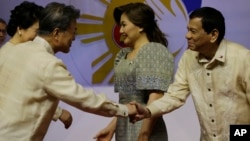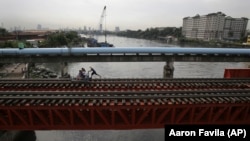Development projects in the Philippines may increase competition between South Korea and China.
Philippine President Rodrigo Duterte is seeking partners to develop his country, which is in need of improved roads, ports and railways to attract investment.
South Korean President Moon Jae-in appealed to members of the Association of Southeast Asian Nations (ASEAN) this month at its meeting in Manila. He told members, including The Philippines, that his country was “the best partner to share the experience” of economic growth.
South Korea is offering to help with technology projects, railways, clean energy development and water management.
The Philippines wants to attract development assistance. Since Duterte took office last year, the country has increasingly turned to China.
China promised $24 billion in aid in October of 2016. Earlier this month, China and the Philippines signed 14 economic cooperation agreements including one on railways.
In October, Japan’s Prime Minister Shinzo Abe announced $8.8 billion in economic support.
South Korea does not want to lose ground in the Southeast Asian nation of more than 100 million people.
Herman Kraft is with the University of the Philippines Diliman. He says that the United States, Japan and South Korea traditionally have worked together in the region.
“I think one of the things that Korea might actually be concerned about right now is of course, in a similar groove with Japan, they’d like to make sure that the Philippines doesn’t just turn around in terms of its relationship with the United States.”
Duterte improved relations with China last year. He eased tensions with China after about four years of disputes related to territory in the South China Sea.
China claims almost all of the South China Sea as its territory. The Philippines claims many land formations and islands in the eastern part of the sea.
At the same time, Duterte appeared to seek less American support of his country’s armed forces.
Korea extends aid to The Philippines
This month, local media reported that South Korea offered $1.7 billion in credit and financial aid to help the Philippines. The money, the report said, was aimed at developing transportation and energy projects.
Duterte is seeking $167 billion to build public infrastructure, such as roads, rail lines, ports and power centers. But The Philippines needs foreign investment.
Manila’s seaport, for example, is crowded. Electricity costs in the country are high for the region.
Also, the Philippines has few railways to link cities on its larger islands.
The Philippine National Economic and Development Authority keeps records of development aid in the country. The agency says that South Korea provided more than $600 million dollars in aid to the Philippines in 2013.
Song Seng Wun is an economist specializing in Southeast Asia with the internet banking group CIMB in Singapore. He said South Korea wants its aid efforts to lift its national “brand.”
Chinese brands could become competitors in the Philippine market where South Korean electronic household machines and other products are popular.
Consumer spending is an increasingly important part of the Philippine economy which grew 6.9 percent in 2016.
The total value of trade between South Korea and the Philippines increased from $10 billion in 2011 to $13.4 billion in 2014.
South Korean leaders hope to increase ties with Southeast Asian countries to avoid investing too much in China. Problems with over-investing in China became clear earlier this year. South Korean companies faced boycotts and other problems in China and the number of Chinese travelers dropped sharply.
The trade difficulties took place as South Korea permitted the U.S. to deploy the missile defense system known as THAAD. South Korea and the U.S. have said the system is to guard against missile attacks from North Korea. But China, strongly opposes deployment of the system on the Korean Peninsula.
Jonathan Ravelas is a market expert with Banco de Oro UniBank in Manila. He says The Philippines probably welcomes the help from South Korea as a way to diversify economic support without angering anyone.
I’m Mario Ritter.
Ralph Jennings reported this story for VOA News. Mario Ritter adapted it for VOA Learning English. Caty Weaver was the editor.
_______________________________________________________________
Words in This Story
region –n. a large, separate area of the world or a country
groove –n. a ways of doing things or a way of thought
brand –n. something, like a product, that is easily recognizable and causes people to seek it out
diversify –v. to make something more diverse, to increase the number of possibilities available
We want to hear from you. Write to us in the Comments section, and visit our Facebook page.









